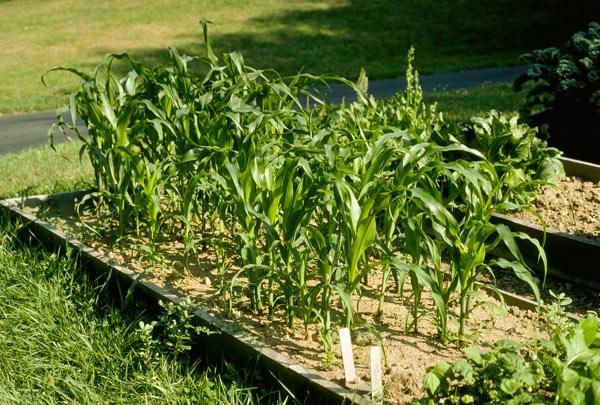Planting corn facts
- Hardiness: Very tender warm-season annual. Frost will injure top growth; needs warm weather to grow.
- Planting: Seed after the danger of frost is past; super-sweet varieties should be planted when soil temperatures reach 65°F. Pre-germinating seed before planting in cool, spring soil may help prevent soil rot or Southern corn rootworm and seed-corn maggot problems. Full sun requires direct light at least 6 hours/day; prefers 8 - 10 hours/day.
- Days to maturity: 63 - 100.
- Spacing: 9"- 12" in-rows x 24"- 36" between rows; minimum of three rows side by side (preferably four rows) to ensure good pollination.
- Fertilizer needs: High requirement for nutrients, either from soil organic matter or fertilizers. Incorporate compost prior to planting. Side-dress twice, when plants are 12- to 18-inches high and again when tassels appear. Refer to Fertilizing Vegetables for details.
- Approximate yield: 5 to 10 lbs. or roughly 10 to 20 ears per 10-foot row.
Common corn problems
Corn earworm
Corn smut
European corn borer
Japanese beetle
Lodged (falls over)
Growing and care of sweet corn
- Sweet corn (Zea mays convar. saccharata var. rugosa) is a variety of maize with a high sugar content. It is picked when immature (milk stage) and eaten as a vegetable, rather than a grain. Since the process of maturation involves converting sugar into starch, sweet corn stores poorly and must be eaten fresh before the kernels become tough and starchy.
Three basic types of hybrid sweet corn- many cultivars combine the genetics of more than one type
- Sweet corn varieties differ significantly in days to maturity, kernel color, and sugar content. Most cultivars are hybrids that have been bred for greater vigor and higher yields. A continuous harvest can be planned by planting early-, mid-, and late-season varieties. Successive plantings of the same variety can be made every two weeks or when the previous planting has three to four leaves.
- Early maturing cultivars tend to produce relatively small plants. Plant this type in rows 30 inches apart with plants 8 to 9 inches apart. For medium to large plant varieties, use a 36-inch row spacing with plants 12 inches apart in the row.
- Baby corn is simply immature corn produced on cultivars with a dwarf habit (takes up less space). Harvest when the silks develop but ears are not yet fertilized.
- Corn sown in early spring will take longer because of cool soil and air temperatures. Use only the quickest maturing cultivars for July plantings. Keep in mind that several caterpillar pests may be present in great numbers by late summer. Always select cultivars with leaves that form a tight cover at the tip of the ear. This will help prevent pests like the corn earworm from feeding on the ear.
- It is not necessary to remove suckers or side shoots that form on sweet corn. With adequate fertility, these suckers may increase yield, and removing them has been shown in some cases to actually decrease yield. Support the growing stalks with one or two strands of heavy string around the perimeter of the planting to prevent lodging (plants falling over) during thunderstorms.
- Watering - Keep plants uniformly supplied with moisture, especially during establishment, flowering, and ear development. Water deeply and regularly during dry periods.
- Weeding - Hand pull weeds when soil is moist or slice weeds at the soil line. An organic mulch will help conserve soil moisture.
Corn pollination
- Corn is wind-pollinated. Plant in blocks of at least three to four short rows, rather than one or two long rows, to ensure good pollination and full kernel development.
- Most of the various types of corn cross-pollinate readily. To maintain desirable characteristics, extra-sweet and standard sweet corn should be isolated from each other by distance (400 yards) or planting time (two weeks). Sweet corn plantings must be isolated from field corn as well. White and yellow types will also cross-pollinate, altering kernel color.

Harvesting corn
- Corn should be harvested when husks are still green, silks brown and dry, kernels full size and yellow or white to the tip of the ear; at milky stage (use a thumbnail to puncture a kernel – if the liquid is clear the corn is immature; if milky it’s ready; and if no sap, you’re too late.)
- Cover immature ears with paper bags to prevent insect or bird damage.
- Corn matures 17 to 24 days after the first silk strands appear, more quickly in hot weather, more slowly in cool weather.
Storage and preservation
- Field heat can be removed from ears by plunging them into ice-cold water (add a teaspoon each of bleach and lemon juice per gallon of water) for 15 minutes.
- Drain the ears and store them in the refrigerator (4 to 5 ears to one-gallon plastic or mesh bag) until ready to use.
- The corn of the newer types will remain sweet and fresh for 2 to 3 weeks.
